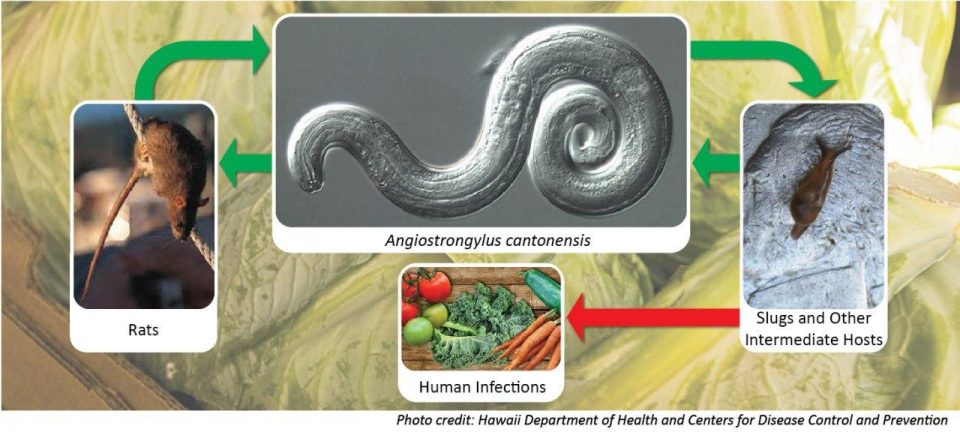
By Alfred Acenas
EBC Hawaii Bureau
HONOLULU (Eagle News) – The Hawaii Department of Health (DOH) confirmed on Friday, May 15, a case of angiostrongyliasis, more commonly known as rat lungworm disease. The individual in question is a resident of Maui and is the first person this year to test positive. In 2019, there were a total of 9 reported cases.
The individual sought treatment and was hospitalized at Maui Memorial Medical Center. The investigation was not able to identify an exact source of infection.
Rat lungworm disease is caused by a parasitic roundworm and can have debilitating effects on an infected person’s brain and spinal cord. In Hawaii, most people become ill by accidentally ingesting a snail or slug infected with the parasite Angiostrongylus cantonensis.
Symptoms vary widely between cases; the most common ones include severe headaches and neck stiffness. The most serious cases experience neurological problems, severe pain and long-term disability.
“In the midst of the COVID-19 situation, we need to also be mindful of other diseases such as rat lungworm,” said Dr. Lorrin Pang, Maui District Health Officer, “With many people starting their own home gardens for self-sustainability, we’d like to remind everyone to thoroughly inspect and rinse all fresh fruits and vegetables under clean, running water. For added prevention, cooking food by boiling for three to five minutes or heating to an internal temperature of 165 degrees Fahrenheit (74 degrees Celsius) for at least 15 seconds can kill the parasite that causes rat lungworm disease.”
Below are tips on how to prevent rat lungworm disease:
- Control snail, slug, and rat populations around homes, gardens, and farms. Get rid of these vectors safely by clearing debris where they might live and also using traps and baits. Always wear gloves for safety when working outdoors.
- Inspect, wash, and store produce in sealed containers, regardless of whether it came from a local retailer, farmer’s market, or backyard garden.
- Wash all fruits and vegetables under clean, running water to remove any tiny slugs or snails. Pay close attention to leafy greens.
Dr. Pang added, “We have been routinely monitoring slug populations in vegetable gardens at a sentinel site on Maui since the earlier part of this year. The counts have remained moderate to high and we are setting up a field intervention study to control the slug population.”
According to the Hawaii Invasive Species Council, the adult form of the rat lungworm can infect rodents, which can then pass the larvae of the parasite in their excrement. Snails, slugs and certain other animals (including freshwater shrimp, land crabs, and frogs) can serve as “intermediate hosts” ingesting the larvae. Humans can become infected by ingesting the parasite if they eat the said “intermediate hosts” raw or undercooked.
The Governor’s Joint Task Force on Rat Lungworm Disease is in the process of updating guidelines for Hawaii physicians, which provide clear diagnosis, treatment, and management guidance for timely identification and care for patients who have contracted the disease. The current guidelines are available at: https://health.hawaii.gov/docd/files/2018/08/RLWD_Preliminary_Clinical_Guidelines_FINAL_082918.pdf.
(Eagle News Service)
